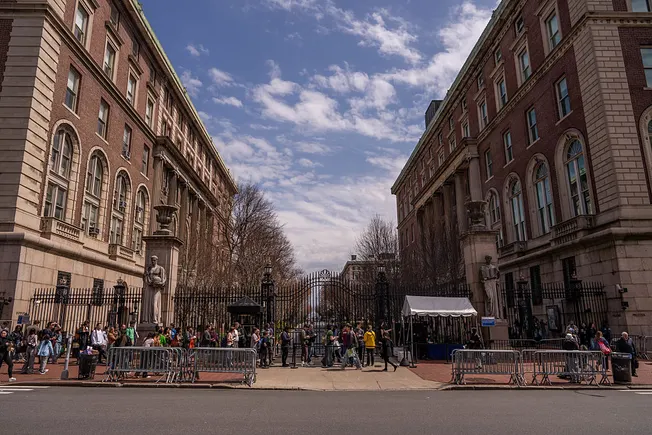On Dec. 13, 2023, Office of Space Commerce Director Richard DalBello testified before the Senate Committee on Commerce, Science, and Transportation, at a hearing on “Government Promotion of Safety and Innovation in the New Space Economy.” (Photo: NOAA Office of Space Commerce)
WASHINGTON — The Commerce Department official responsible for overseeing the planned shift of non-military space tracking from the Defense Department said today that operators should not expect a near-term, or abrupt, change-over — suggesting that the process likely will stretch beyond the next five-year horizon.
“The rollover from DoD to Department of Commerce is a phase transition. As you know, DoD is very, very large. And there are lots of DoDs,” Richard DalBello, director of the Office of Space Commerce at the National Oceanic and Atmospheric Administration (NOAA), told a meeting of the Washington Space Business Roundtable.
NOAA is the Commerce Department’s arm that currently regulates commercial remote sensing, and has been tapped by both the Trump and Biden administrations to expand its role to monitoring the heavens and helping commercial, civil (think NASA) and foreign space operators avoid on-orbit crashes.
“We are now in bunch of working groups … but how we get data from the DoD, how they stand down on the missions that they have been performing, how we stand up the what will be the TraCCS outreach to the world and how we stand down in SpaceTrack.org, all these things are going to be very slow,” DalBello said.
TraCCS, for Traffic Coordination System for Space, is the Commerce Department’s embryonic construct for keeping tabs on the heavens. SpaceTrack.org is the public website where DoD publishes rough coordinates of the whereabouts of space objects, although not all US or allied military and Intelligence satellites are included in that so-called catalog.
TraCCS, at least in the near term, will need to rely on the detection and tracking capabilities of the military ground- and space-based radars and telescopes that are used to provide data to SpaceTrack.org, as well as the “high-accuracy” data set used internally by the Space Force’s 18th Space Defense Squadron to watch adversary spacecraft and monitor for any potential on-orbit collisions. However, Commerce’s goal is to largely lean on commercially available space monitoring capabilities and services.
While the Office of Space Commerce is under the congressional gun to get something up and running by the end of the year, DalBello said, that will be by far from the finished product.
“We have told Congress, and we’ve told the administration, we’re going to do this as an agile development. It’s not going to be like a ‘boom’ milestone delivery where one day there’s nothing and the next day, there’s a finished system. It’s going to be like your cell phone, we’ll be doing updates continually, forever,” he said. “And so we want to get an initial system in by the end of the year, and then grow that system as fast as we can access resources.”
DalBello said that rather than a single-point handover of operations from DoD, “there’ll be this slow transition where we’ll gradually pick up stuff and they’ll gradually step back from civil and commercial. … That’s not a bad thing. Because one of the things we’ve heard from operators along the way is, please don’t just drop everything so that we’re scrambling to to understand what the world looks like.”
He added that, in his assessment, it will take five years to get “fully through the first phase of the transition from DoD,” a clear signpost that this is going to be a very long process.
Eventually, the Office of Space Commerce has hopes that TraCCS will provide more accurate, and crucially more timely, tracking of space objects, as well as more precise warnings of potential space smash-ups than currently made available to operators by DoD.
“What the Defense Department was doing was the very basics of SSA [space situational awareness]. They were providing a very, very, very minimal product,” DalBello said. Thus, “tackling” the challenge of providing a souped-up service “is an issue right now” for his team.
While Commerce still hasn’t come to a final conclusion about “how much is enough” for TraCCS to provide operators for free, the planned “baseline” service will at a minimum publish more frequently updated coordinates for space objects, DalBello explained.
“DoD does updates every eight hours. We’ll double that … at the start of our system. So, we’ll be doing the updates every four hours,” he said.
Meanwhile, DalBello said that one of the reasons Commerce is working with SpaceX under a new Cooperative Research and Development Agreement (CRADA) is to understand how the company manages its Starlink mega-constellation so that the thousands of satellites all are maneuvered into where they need to be at any one time — and avoid hitting each other, the satellites of other operators, and free-floating space junk.
The goal is to get to the point “in addition to whatever tracking [we] deem necessary,” space objects themselves are “reporting all the time” to the TraCCS system about where they are, he said. This could allow the system to push out tracking updates “in a semi-autonomous fashion.”
He noted there is a lot of innovation going on about how to automate space traffic management, such as “such as very-little cost trackers, which could be placed on satellites, which would have their own power source so that even if satellite died, that the location the precise location of the satellite would still be known.”




















Discussion about this post